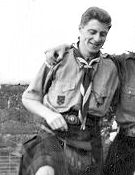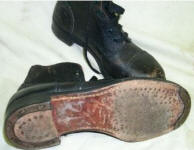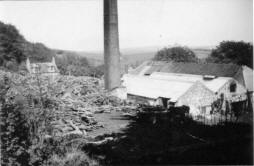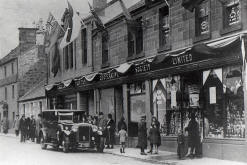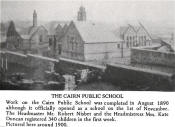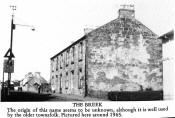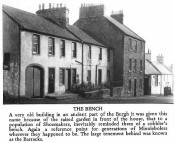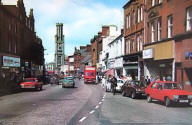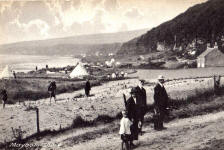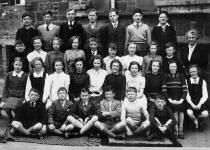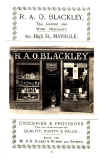|
Remembrances and stories of Minniebolers and their connection with Maybole. If you have a story please contact us. |
|||||||||||||
|
|||||||||||||
|
|
|||||||||||||
|
|||||||||||||
|
|
|||||||||||||
|
|||||||||||||
|
|||||||||||||
|
|
|||||||||||||
|
|||||||||||||
|
|
|||||||||||||
|
|||||||||||||
|
|
|||||||||||||
|
|||||||||||||
|
|
|||||||||||||
|
||||
|
|
||||
|
A snapshot of life on
Kirkland Street, Maybole from mid to late 1930s through the experience
and eyes of a then young lad.
Activities: Sitting barefoot on the
pavement on a warm summer day watching the men apply tar to the surface
of Kirkland St., from a spray attached to a tar boiler then there would
be an application of chips (small stones} followed by a rolling from the
steam roller. I loved the smell of tar and often wound up with stubbed
toes on my bare feet. Watched the drovers driving the cattle from the
goods station at the top of the Red Brae down
Kirkland St., to the
slaughter house at Baloney. Watched the horse teams haul
Jim McAlpine. |
||||
|
|
||||
|
|
||||
|
|
||||
|
|
||||
|
Mr. A. B. Coburn - Headmaster Cairn School. As remembered by Tom McQuiston.
One of the other things that I remember was his ring. He had a black ring on his finger, which one I cannot remember, and I was told that it was made of polished lava. It was very impressive. (It may have been onyx.) Whenever he came into the classroom all the pupils stood until told by Mr.Coburn to sit down. But that happened when any adult person came into the classroom, well maybe, except for the Janitor. Of course it must be remembered that Britain was at war in those days. It was at that time I learned to knit. We knitted nine inch squares that were eventually, with others, stitched into the size of a blanket and sent to the men in the submarines. But, I digress. Alex Coburn was a wonderful musician. He could play anything on the piano. At least once a week he would come into the classroom and have us sing. I think that there was a piano in each classroom. He would screw up his face, rub it, and standing, would play the piano with what seemed like ten hands!! Oh, it was not a concert, it was to accompany us to sing. And the songs were, (this sounds like the Oscars), Elgar's "Land of Hope and Glory", and the Sailors Hymn, "Eternal Father Strong to Save". I have never forgotten these two works, and to this day when the hymn is played, and I must admit that it is not sung too often in almost land locked Manitoba, my thoughts go back to the days at Cairn School and Alex Blue Coburn." Note: Mr A. B. COBURN retired as Headmaster of Cairn School in 1954. He had been appointed to his position in 1927 and was only the second headmaster the school had had since it opened in 1890. He was succeeded by Mr J. Nicolson. |
||||
|
.....Starting school in the Huts behind Cairn School and moving up to the new Carrick Academy in about second grade. What a transition. .....Sunday school picnics from the Glen Kirk always to Girvan. Marching to the station and boarding the train. Rev. Alec Williamson was the minister and Mrs. Williamson was always in charge of the buns and food. ......Singing in the choir of the Glen Kirk and always after the service on a Sunday night walking down the Low Road with chums and meeting and greeting other friends on the road. Always ending up at Amos Biagi's for ice cream and hot peas. ....Billy Arroll's taxi to the shore - before everyone had cars. It was a great place for picnics. We would even walk to the shore (4 miles) or ride bikes - what energy. Latterly my family had a little cottage at Croy shore where we spent wonderful summers at Croyburnfoot... .....The Whist drives and dances at the Town Hall on a Friday night for all the different charities. We didn't go to the Whist but to the dances later - all dressed up in our long gowns.
..... The Wednesday night concerts in the Memorial Park by the Burgh Band conducted by Johnny Hempkin who made the children stop running around and sit down and listen. .....I remember meeting Robert MacBryde and also Robert Colquhoun in his mother's small shop in Weaver Vennel. He must have been minding the shop when his mother was away and he gave me a drawing lesson on how to draw a hand. I never realised at that time that he could become so famous. I was a small kid at the time. .....The weekend War was declared on 3rd September l939 when all our lives changed. That weekend all the evacuation plans went into operation with the Red Cross and civic committees in full force. A train arrived in Maybole with children from Glasgow and before nightfall all these children were billeted with families in the town and many of them stayed with the families for a long time. There was such a wonderful spirit in the town and everyone pulled together to help. Luckily Glasgow was not bombed early in the War and we were designated a safe area. Soon our young men started to go off to the services and I well remember the terrible blackout where one could not show a chink of light from the windows or the Air Raid warden came to call. I joined the local Fire Brigade and everyone joined one of the organizations to help the war effort. As my father was Provost at the time and I worked with David Briggs the Town Clerk we were very involved in all the arrangements. A lot of charity affairs but no more long gowns and ration books for clothes and food became the order of the day. .....My memories of the old town were from another era - a much slower time - but with much fun and I think back on it with great fondness I left it in l946 to travel the World but it will always have great memories for me
Margaret Pedersen
I've been pouring through some old memory boxes and have come across a newspaper clipping of my father's death and it mentions his participation in the Sloan Pavilion. Many invitations to affairs with Royalty etc. and it has been interesting reading. In my mind I can still picture the High Street as it used to be and I had great fun trying to reconstruct the merchants in the 20's and 30's. I remember Alan Dent and have his books. Also his father John Dent who had a candy shop at the Town hall. What an interesting old man he was. Well enough already - ... bringing back a lot of old memories.
Margaret Pedersen I am hopeless with names; I have a clear picture of events since 1920. I have had a series of strokes which has disabled part of my brain. I remember the secretary of the Baptist Church at that time - Hugh B MacFadzean; ( the boss of Jack's works. I remember one of the deacons , the chemist Martin Lindsay ( whose son I knew as boys, and has now inherited the business ) I wonder what has happened to Jim Strachen, the son of the local librarian. We used to first and second in the class. The last time I identified with Maybole was in 1962. I was at the time taking part in a professional play, produced at the Westminster Theatre. After touring the main provincial theatres, we were invited to USA. We started in Los Angeles and went right across to Boston, and then Canada. The incident happened in Palm Springs, where the Chairman of Rexalls, invited his neighbours and his house-guests who happened to be ex-President Dwight Eisenhower and the First Lady. ( after the world war II they gave him of Culzean Castle because of what he had done in the War). Eisenhower wanted to meet the cast. I positioned my self at the end of the line. After the stars, he passed along the line. I stopped with the statement - "I come from Maybole, sir" to which he replied "oh, they want me to be chairman of the local bagpipe band." he enjoyed the conversation and introduced me to Mamie. Don Simpson
[Friends
of ours gave us the web address and we passed it along to our Uncle Rev.Donald
Simpson now 82 and retired to a London England nursing home. His Father the Rev.
David Melville Simpson was invited to be the first full time minister in 1919 to
the Baptist Church in Maybole. Arriving in Maybole they found the Manse not
ready so found themselves occupying rooms in the house of Thomas Ramsey on Shore
Road (the boot maker). David Simpson had three children a daughter- Elizabeth
Brotchie Simpson ( my late mother-in-law) and Donald Simpson my wife's Uncle -
still alive in England and David Simpson who died in 1952.. They attended the
Primary School in army huts - the school itself had been burnt during WW1. They
then were to be the first pupils in Carrick Academy which was then built. This
is being sent to you to help fill in any "holes" in history. Donald
Simpson's e-mail is Don-Simpson@morden.freeserve.co.uk
]
I log on every week and read the Ayrshire Post
headlines. In the Baptist church centenary celebrations I found a
picture of my grandmother among a group of women cleaning for the
church. I remember this picture well from my grandmother's house in the
Ailsa buildings when I visited her as a child. It is so wonderful to
bring up past history after l00 years. I think an aunt of mine Mary
Lauchlan Martin may also be in the picture but I can't be sure of this.
Thank you all so much for your good work on this. Italian Prisoner of War Camp in Maybole - by Peter Cleave During the nineteen forties Murray gardens was used as a POW for Italian soldiers who were captured in the 1939 -1945 Second World War. I live in Murray Gardens now and I wonder what it was like living in the 1940s in Maybole. At that time in Alloway Road there were air raid shelters built to protect local people in the event of enemy air action. I remember visiting the shelters many years ago. They were quite dark dreary inside. It must have been frightening staying there during the war years, hearing aeroplanes at night in the sky above. In Murray Gardens you can still see corrugated huts in the grounds of the SAS factory in Maybole. These were used as living quarters for the prisoners. I gather that after the war had ended some of the POWs stayed in Scotland, finding work to earn a living. I moved from Glasgow to Maybole in 1965. I had heard many stories about what it was like in Glasgow during the war, where many people died during air raids. In Maybole there is a memorial to soldiers who fought and died during the war and there is a memorial service every year when a poppy wreath is laid to commemorate the dead. Thanks to Britain and the Allied Forces we now live in peace. |
